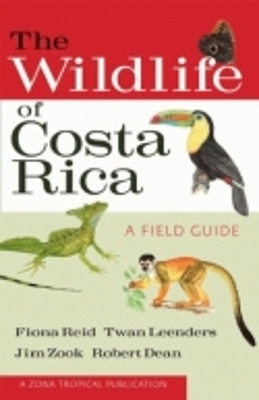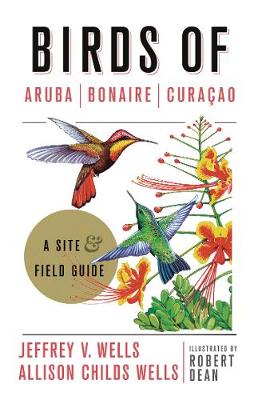Zona Tropical Publications
4 total works
The Wildlife of Costa Rica
by Fiona Reid, Twan Leenders, Jim Zook, and Robert Dean
This full-color field guide is an indispensable companion to the most popular neotropical ecotourism destination: Costa Rica. Featuring all the mammals, birds, reptiles, amphibians, and arthropods that one is likely to see on a trip to the rainforest (as well as those secretive creatures such as the jaguar that are difficult to glimpse), The Wildlife of Costa Rica is the guide to have when encountering trogons, tapirs, and tarantulas.In addition to providing details for identifying animals along with interesting facts about their natural history, this guide offers tips for seeing them in the wild. Costa Rica, a peaceful nation with many and diverse animal species, is one of the best places in the world for wildlife watching and nature study. It has an excellent system of national parks and reserves, a wide choice of ecolodges, and many professionally trained tourist guides. It is possible to leave the capital city of San José and, just a few hours later, visit a high-elevation cloud forest, dense rainforest, savanna-like plain, or coastal habitat, each with a unique collection of animal species.This new lightweight field guide provides nature enthusiasts visiting Costa Rica with the best introduction to the country's amazing diversity of wildlife. It is the first general field guide to Costa Rica to combine the most sought-after features:•treatment of all major phyla in the country;•coverage of the animals most likely and most desirable to be seen;•more than 600 detailed illustrations integrated with the text (the preferred method of animal identification in the wild);•full species accounts including ID points, range and habitat, size, and behaviors;•a wealth of natural history information, including more than 20 photographic natural history features; and•tips for seeing animals.
Birds of Nicaragua
by Liliana Chavarria-Duriaux, Robert Dean, and David C. Hille
Birders in Central America have long known that Nicaragua is one of the best birding locations in the world, and with tourism to the country on the upswing, birders from the rest of the world are now coming to the same conclusion. The largest country in Central America, Nicaragua is home to 763 resident and passage birds, by latest count. Because of its unique topography—the country is relatively flat compared to its mountainous neighbors to the north and south—it forms a geographical barrier of sorts, which means that many birds that originate in North America reach their southernmost point in Nicaragua, while many birds from South America reach their northernmost point in the country. There are few places in the world where you can find both a Roadrunner and a Scarlet Macaw.
Birds of Nicaragua features descriptions and illustrations of all 763 species currently identified in the country, along with information about 44 additional species that are likely to appear in the coming years. Range maps, based on years of field research, are color-coded. Other features include a richly illustrated anatomical features section, a checklist, a visual guide to vultures and raptors in flight, and a quick-find index.
Birds of Aruba, Bonaire, and Curacao
by Jeffrey V. Wells, Allison Childs Wells, and Robert Dean
Birds of Aruba, Bonaire, and Curaçao is the essential guide for anyone traveling to those islands. It showcases the more than 280 species seen on Aruba, Bonaire, and Curaçao and provides descriptions of and directions to the best places to bird, from the famous white sand beaches to hidden watering holes to the majestic national parks.
Aruba, Bonaire, and Curaçao—the "ABCs"—located in the southwestern Caribbean, not far from Venezuela, share fascinating ecological features with the West Indies as well as the South American mainland, making birding on the islands unique. The identification portion of the book features endemic subspecies such as the Brown-throated Parakeet; a wide variety of wintering North American migrants; spectacular restricted-range northern South American species such as the Yellow-shouldered Parrot, Bare-eyed Pigeon, Troupial, Ruby-topaz Hummingbird, and Yellow Oriole; and West Indian species including the Pearly-eyed Thrasher and Caribbean Elaenia.
Colorful introductory sections provide readers with a brief natural history of the islands, detailing the geography, geology, and general ecology of each. In the site guide that follows, Jeffrey V. Wells and Allison Childs Wells share their more than two decades of experience in the region, providing directions to the best birding spots. Clear, easy-to-read maps accompany each site description, along with notes about the species that birders are likely to find.
The identification section is arranged in classic field guide format and offers vivid descriptions of each bird, along with tips on how to identify them by sight and sound. The accounts also include current status and seasonality, if relevant, and common names in English, Dutch, and Papiamento, often inspired by the unique voices of the birds, such as the "chibichibi" (Bananaquit) and "choco" (Burrowing Owl). The accompanying color plates feature the beautiful work of illustrator Robert Dean.
The final section, on conservation, raises awareness about threats facing the birds and the habitats on which they rely and summarizes conservation initiatives and needs, offering recommendations for each island.



